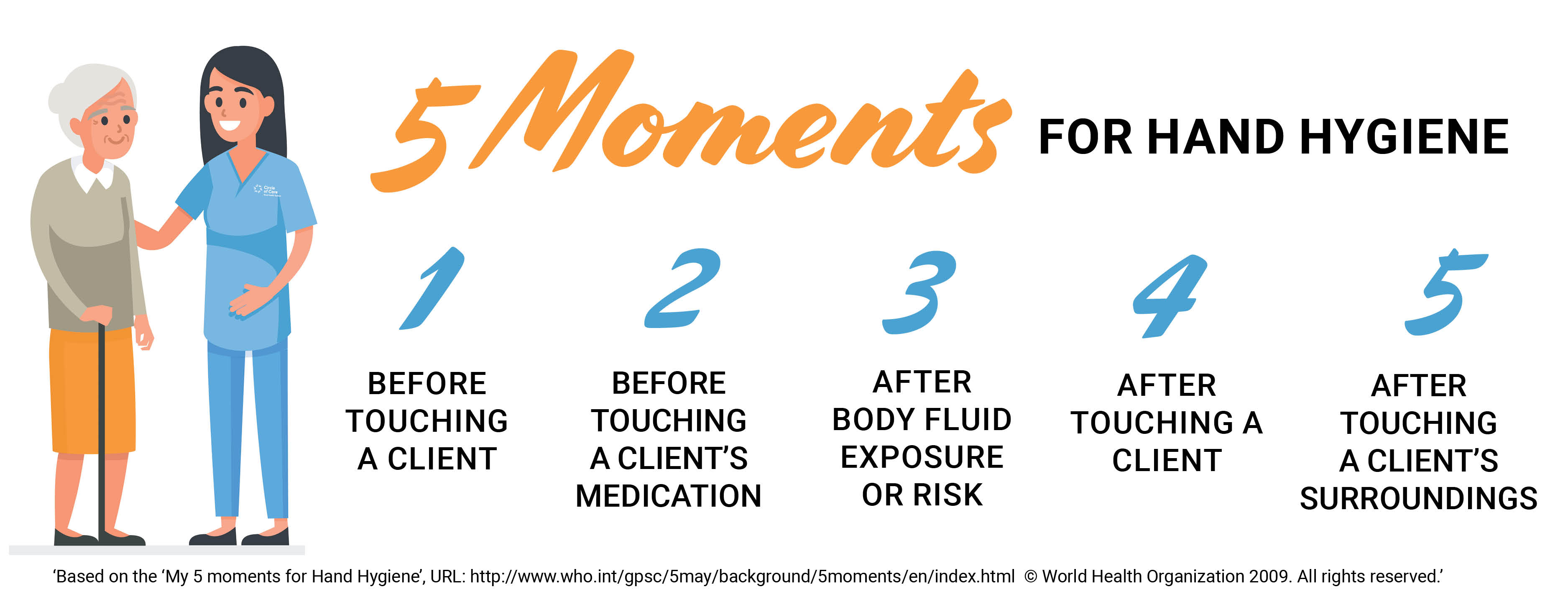When should I wash my hands?

How well do you clean your hands?
Best practice recommendations to enable effective hand hygiene:
- Nails must be kept clean and short
- Nail polish, if worn, must be fresh and free of cracks or chips
- Artificial nails or nail enhancements must not be worn
- It is preferred that rings not be worn
- Hand and arm jewelry, including watches, must be removed or pushed up above the wrist by staff caring for clients/patients/residents before performing hand hygiene
When should I use soap and water:
- When hands are visibly soiled with dirt or organic substances (e.g., blood, mucous)
- In health care facilities bar soaps must not be used for hand hygiene
- Bar soaps are allowed for personal use and must be stored in a soap rack to allow drainage and drying
- Sanitizer should not be used immediately after hand washing with soap and water as it will result in more irritation of the hands
Follow the steps listed for proper hand washing with soap and water:
- Step 1: Wet hands with warm water.
- Step 2: Apply soap.
- Step 3: Wash hands for at least 20 seconds (including your palms, back of each hand, between fingers, thumbs and under nails).
- Step 4: Rinse well.
- Step 5: Dry hands well with paper towel.
- Step 6: Turn off tap using paper towel.
When should I use alcohol based hand sanitizer?
- When there is no visible dirt on hands
- Use 70 to 90% alcohol-based hand rub for hand hygiene in all health care settings
- Sanitizer should not be used immediately after hand washing with soap and water as it will result in more irritation of the hands
Follow the steps listed for proper use of sanitizer for hand hygiene:
- Remove hand and arm jewelry.
- Apply enough alcohol-based hand rub to make about the size of a quarter onto your hands, enough when you rub your hands together to cover all areas of your hands, including under your nails (1-2 pumps).
- Use a rubbing motion to evenly distribute the alcohol-based hand rub over all surfaces of the hands, particularly between fingers, fingertips, back of hands and base of thumbs.
- Rub hands until your hands feel dry (minimum 15-30 seconds).
Use of Towelettes/Wipes for hand hygiene:
- Can be used when visible soil is present on hands and running water is not immediately available to remove the visible soil, followed by sanitizer (e.g., prehospital care, home care)
How does jewelry and nail polish impact hand hygiene?
According to Best Practice Hand Hygiene from Public Health Ontario, Nail Polish [pg. 17-18]:
- Chipped nail polish or nail polish worn longer than 4 days can harbour microorganisms that are not removed by hand washing
- Nail art (adding decorative paint effects to nails) has been shown to be associated with outbreaks of infection
- Acrylic nails harbour more microorganisms and are more difficult to clean than natural nails
- Artificial nails and nail enhancements, such as gel nails and nail wraps (adhesive decorative plastic or vinyl attached to nails), have been implicated in the transfer of microorganisms
- Artificial nails and nail enhancements are also associated with poor hand hygiene practices and result in more tears to gloves
- For these reasons, artificial nails and nail enhancements are not to be worn by those having direct contact with a client/patient/resident
According to Best Practice Hand Hygiene from Public Health Ontario, Hand and Arm Adornments [pg. 18]:
- It is recommended that rings and bracelets not be worn by those with direct contact with a client/patient/resident
- A watch, if worn, should not be manipulated or touched
- Rings increase the number of microorganisms present on hands, may increase the risk of tears in gloves
- Jewelry that is very hard to clean hides bacteria and viruses from the action of the hand hygiene agent
- If watches and other wrist jewelry are present, remove or push up above the wrist before performing hand hygiene
